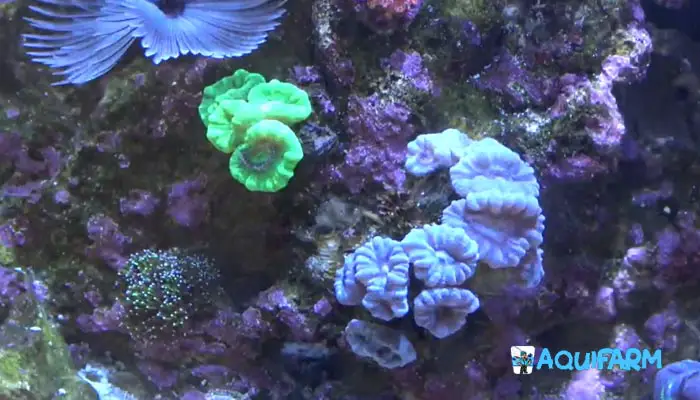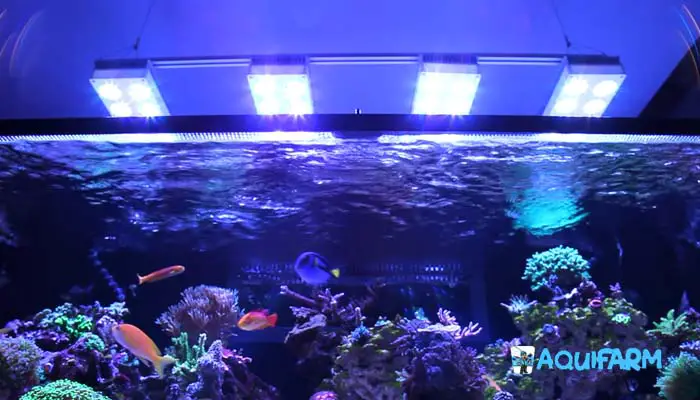Candy Cane Coral Care- Complete How To Guide
Candy cane coral (also sold as trumpet coral; genus Caulastrea) is a shallow-water, hardy LPS that prefers sandy or rubbly habitats. They’re great for beginners because they tolerate minor swings better than many LPS. Short-term slips in salinity or calcium usually don’t crash them—so you’ve got a little slack while you learn.
But if key parameters drift for too long, candy cane corals suffer. Knowing when to step in—and how—is the difference between steady growth and receding tissue. In this guide, I’ll show you the simple routine and core candy cane coral care that keeps them happy.
Let’s dive in.
How to Take Care of a Candy Cane Coral
Care is straightforward once you match their preferences. Here’s the quick reference before we go deeper.
Candy cane coral requirements at a glance:
Features | Requirement |
| Preferable location | Lower rockwork or sandbed (stable base) |
| Tank size | Small to medium (nano-safe) |
| Behavior | Generally peaceful; give space for sweepers |
| Difficulty level | Beginner-friendly LPS |
| Temperature | 76–80°F (24–27°C) |
| Lighting | Low–moderate light (≈50–90 PAR) |
| Water flow | Low–moderate, indirect (no tissue whipping) |
| Water pH | 8.1–8.4 (stable) |
| Alkalinity | 8–11 dKH (consistent) |
| Specific gravity | 1.024–1.026 (35 ppt target) |
Placement of Candy Cane Corals

Aim for a habitat that mirrors their natural environment: stable base, gentle flow, and modest light. Candy canes don’t need a big tank—many thrive in nanos if nutrients and salinity are stable.
For trumpet coral placement, the sandbed or lower rockwork is ideal. They’ll happily encrust rubble or small shelves. Try a few lower spots and watch polyp extension—full, puffy heads are a good sign you’ve nailed it.
Leave room for growth. As colonies expand, longer nighttime feeding tentacles can sting neighbors. Provide a buffer zone so they don’t contact other corals as heads multiply.
Water Parameters for Candy Cane Corals

Stable reef parameters fuel candy cane coral growth. They tolerate brief bumps, but long swings in salinity, alkalinity, or temperature lead to receding tissue. Use a reliable saltwater/reef test kit—not a freshwater kit—to track the basics. (Our Recommendation: API Saltwater Master + Reef Test Kit or equivalent)
Here’s how to manage the big three factors you mentioned.
Temperature
Keep 76–80°F. Heat spikes can stress zooxanthellae (bleaching risk); cold snaps slow metabolism. In warm spells, increase surface agitation, open the lid, aim a fan across the water, or use a chiller. In cold spells, rely on a calibrated heater—don’t crank lights just for heat.
Frequent 24-hour water changes aren’t needed for temperature control; target stable room climate and appropriate equipment instead.
Light
Candy canes prefer low–moderate light (≈50–90 PAR). Too much light can bleach tissue; too little slows growth. Modern reef LEDs with a blue-heavy spectrum work well—avoid intense white directly above them. Provide 10–12 hours total photoperiod, and acclimate slowly when upgrading lights.
Watch for signs: pale or retracted heads may mean excess light; dull colors and poor extension can mean too little. Adjust height or intensity gradually.
Water Flow
Start with low–moderate, indirect flow. Constant blasting causes tissue to pull back from skeleton and can lead to damage. As colonies grow, they tolerate a touch more flow, but the rule is simple: polyp flesh should gently sway, not whip.
A controllable wavemaker or powerhead makes tuning easy. (Our Recommendation: VIVOSUN 800 GPH Submersible Pump or a small DC wavemaker)
Water pH
Target 8.1–8.4 with good gas exchange. Excess CO2 in the room suppresses pH—open a window, increase surface agitation, or use outside-air to the skimmer. Baking soda (sodium bicarbonate) raises alkalinity and can nudge pH, but avoid big jumps; stability beats chasing numbers.
Match new saltwater to display parameters at water changes to avoid sudden swings. Aragonite sand/live rock naturally buffer; crushed coral in marine systems can help but focus on consistent alkalinity (8–11 dKH) via two-part dosing or a kalkwasser regimen.
Candy Cane Coral Fragging
Healthy colonies branch readily, making Caulastrea easy to frag. Use stainless bone cutters or a Dremel to cut between heads—never through the center of a polyp. Wear eye protection and dip fresh cuts to reduce infection risk.
Avoid random, ragged breaks, which can tear tissue and invite recession. Mount frags on rubble and place low with gentle flow until healed.
Feeding Candy Cane Corals
Feeding supports color and growth. Offer small meaty foods (mysis shrimp, enriched brine, finely chopped seafood), micro-foods (reef roids, oyster feast), and natural zooplankton. Target feed near tentacles with a turkey baster or coral feeder; avoid touching tissue.
Feed 1–3× per week (or every other day for faster growth) with return flow lowered so food lingers. Too much flow will blow food off the polyps. If fish (looking at you, clownfish) steal food, distract them on the other side of the tank first.
Remember, candy canes rely partly on their symbiotic zooxanthellae—good light and stable chemistry are as important as target feeding.
Nutrient Requirements
Keep these reef nutrients in range for steady calcification and color:
- Ammonia: 0 ppm
- Nitrite: 0 ppm
- Nitrate: ~2–10 ppm
- Phosphate (PO4): 0.02–0.07 ppm
- Calcium: 400–450 ppm
- Magnesium: 1250–1350 ppm
- Alkalinity: 8–11 dKH (stable)
Prevent nitrate spikes by feeding small portions and maintaining regular export (skimming, water changes, refugium). For calcium/alkalinity, use a two-part solution or kalkwasser; don’t use Epsom salt to raise calcium—it’s magnesium sulfate and will skew Mg/SO4 balance. Use calcium chloride for Ca and sodium bicarbonate/carbonate for dKH.
Some Abnormalities in Candy Cane Corals
They’re forgiving, but certain changes are red flags. Catch them early and correct the cause to avoid loss.
Bleaching
If color washes out to white, that’s bleaching—usually from excess light/heat or chemistry swings. Reduce intensity, stabilize temp/salinity/alkalinity, and keep nutrients detectable (nitrate 2–10 ppm, phosphate 0.02–0.07 ppm). Give them a few weeks of gentle, stable conditions.
Deflating
Occasional deflate/inflate cycles are normal. Persistent shrinkage (>48–72 hours) points to stress: too much flow, abrupt light change, low alkalinity, or salinity swings. Verify parameters and adjust placement/flow.
Exposed Skeletons
Tissue recession exposing skeleton means irritation or unstable chemistry. Stop direct flow, re-stabilize parameters, and consider an iodine or broad coral dip if pests are suspected. Given stable conditions, Caulastrea often re-inflates and re-skins edges.
Read More—
FAQs
Are candy cane corals easy to keep?
Yes. They’re hardy LPS that tolerate modest swings if you keep salinity, alkalinity, and temperature stable—perfect for a first LPS.
How fast does candy cane coral grow?
With stable parameters and occasional target feeding, colonies commonly double heads within a year or so. It’s not unusual to go from 2–3 heads to 7–8 heads in 12–18 months.
Do candy cane corals shed?
They don’t “shed” like some soft corals, but they can produce protective mucus under stress. Persistent slime production signals a parameter or placement issue to fix.
The Bottom Line
This streamlined candy cane coral care routine comes down to stability: salinity 1.024–1.026, alkalinity 8–11 dKH, 76–80°F, low–moderate PAR and flow, and light target feeding. Correct small issues early and you’ll enjoy years of growth and splitting heads.
Keep it simple, test regularly, and adjust gently. If anything feels off, re-check the basics above—then sit back and enjoy those bright, puffy trumpets.
Questions or tank pics? Drop them in the comments—I’m happy to help tune your setup.
- Where Do Catfish Like To Hang Out – Unlocking Their Ideal Aquarium - December 23, 2025
- Noise Making Mechanisms In Talking Catfish – Unlocking Their Secret - December 23, 2025
- How To Prevent Algae On Slow Moving Catfish – The Ultimate Guide To A - December 23, 2025
